AppleInsider · Kasper's Automated Slave
About
- Username
- AppleInsider
- Joined
- Visits
- 52
- Last Active
- Roles
- administrator
- Points
- 10,971
- Badges
- 1
- Posts
- 66,634
Reactions
-
Apple Silicon M2 vs M3 - looking at the future of the Mac
Apple has completed its M2 lineup and is expected to bring out M3 within months. This is what the next Apple Silicon generation can offer over M2.
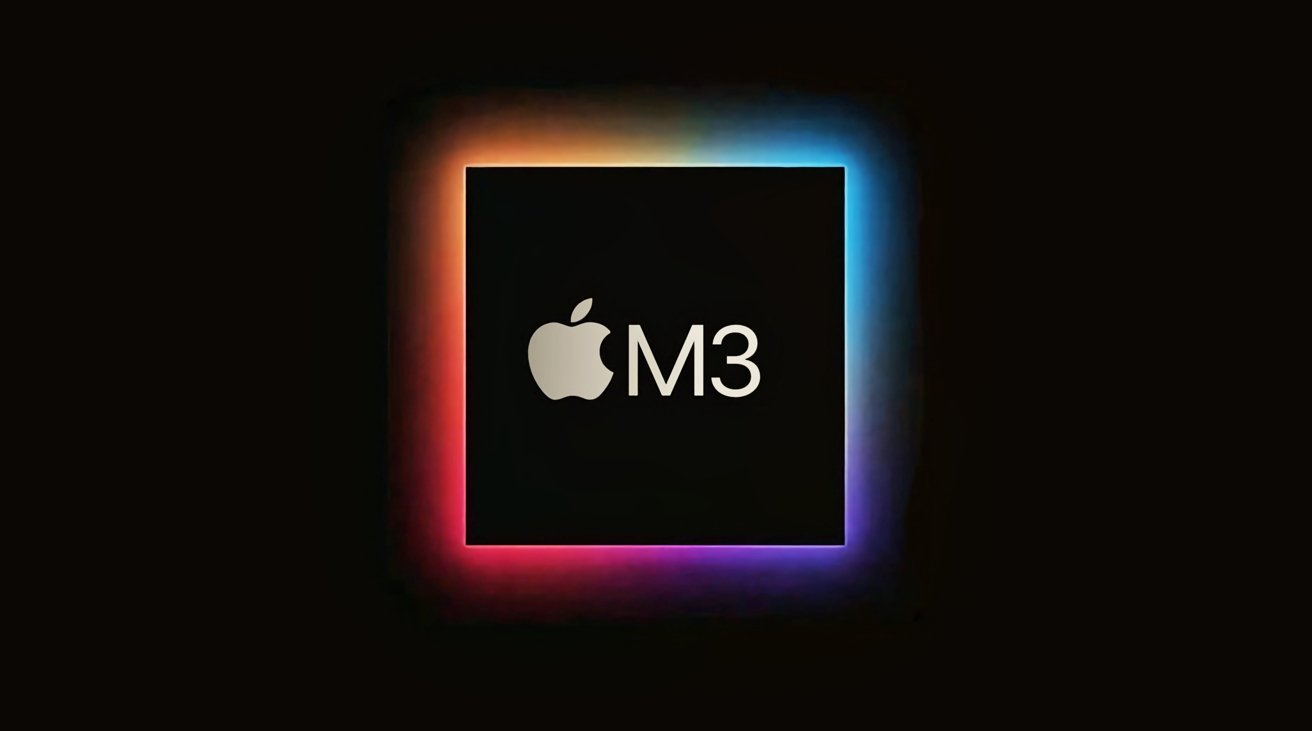
M3
Apple's introduction of new Mac models at WWDC using the M2 Ultra means it has completed its lineup of M2 chips. With the release of the M2, M2 Pro, M2 Max, and M2 Ultra, Apple has filled out the generation with the same variants as its original M1.
Though there's a slim chance that Apple could add more to the lineup, the rumor mill is quite sure that the M2 is complete, and that the M3 generation is the next future upgrade for Apple Silicon.
Apple did a lot with its M2 upgrade from M1, and with the prospect of M3 arriving soon, it's worth trying to guess what Apple could actually come up with for the chip lineup.
Here, then, is AppleInsider's best guess of what could be on the way, based on rumors and some educated guesses.When is M3 coming out?
The easiest thing to consider is when Apple could bring out the M3 lineup. With the effective completion of M2, the first M3 could easily arrive within a few quarters.
Rumors about the chip claim that, with the 24-inch iMac missing out on M2, it is likely to skip ahead and become one of the first Macs running on M3. An October launch, as part of Apple's typical fall release schedule, has already been declared.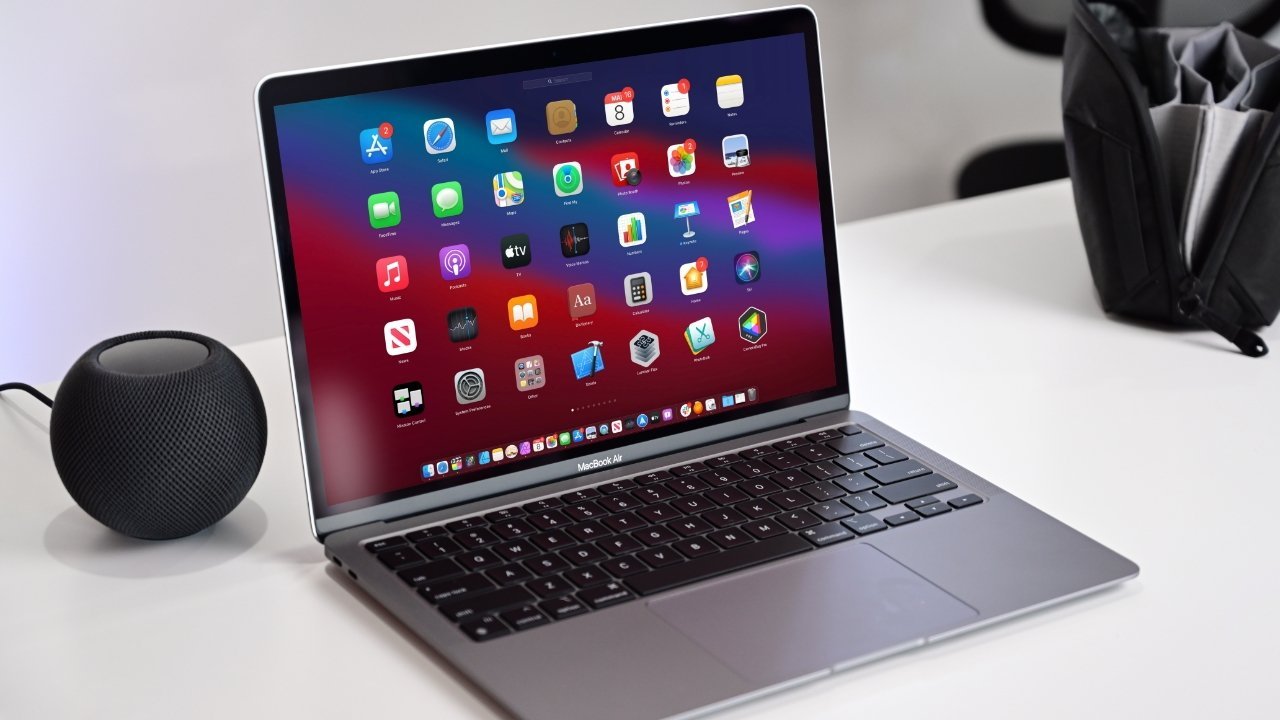
The 13-inch MacBook Air is a good candidate for first-wave M3 Mac releases
Other candidates for the M3 treatment include the 13-inch MacBook Air and the 13-inch MacBook Pro. Lobbing M3 into the Mac mini isn't entirely out of the realm of possibility, either.
There's always a chance Apple could push the launches into early 2024, if it felt the need to give the M2 a bit more space to exist on the market before effectively becoming out of date. But then again, that would mean a whole six months to wait for a new Mac launch, which seems unlikely.M2 vs. M3: A whole new generation
Apple is a creature of habit, and it likes to keep things extremely regular. This takes many forms, including the components used in its various products, and this also extends to its chip lineups.
The M1 lineup was made up of the original M1, followed by the M1 Pro and M1 Max which added more cores and other elements. Then there was the M1 Ultra, which took the M1 Max and doubled everything because it was literally two M1 Max chips connected together.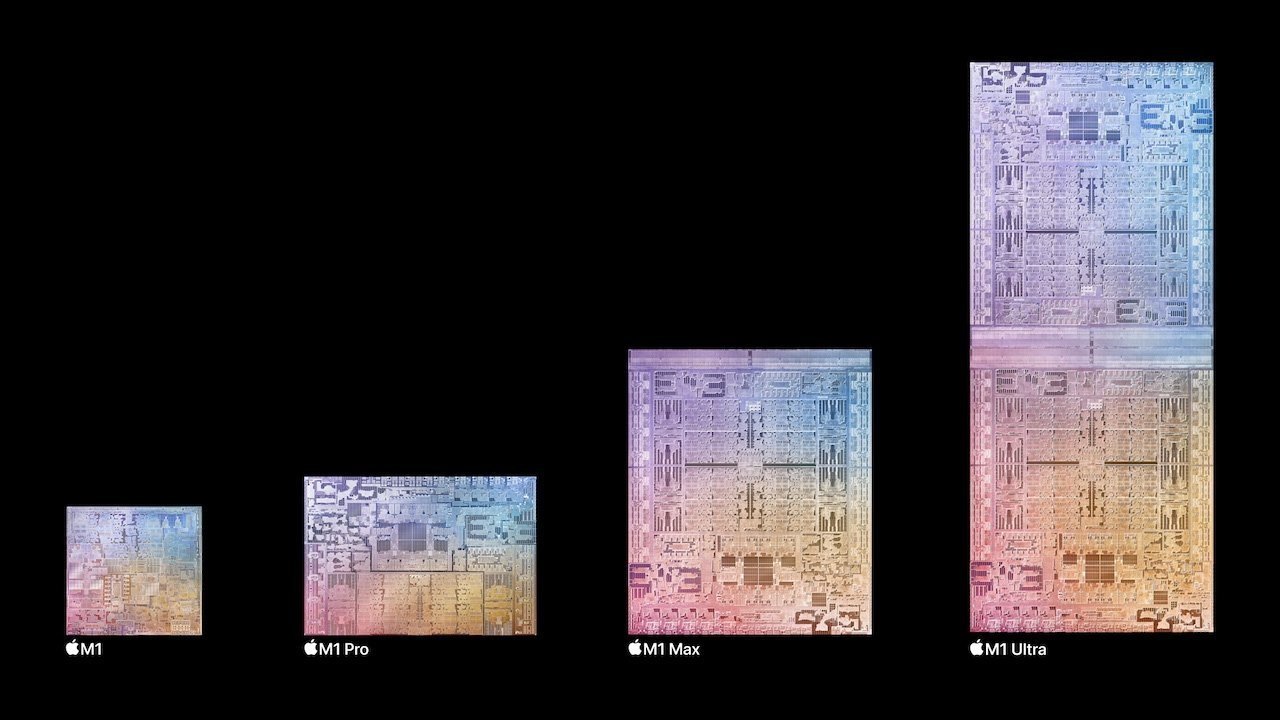
Physical size comparisons of the M1 range of chips
That pattern continued with M2, as the M2 Pro and M2 Max also added more CPU and GPU cores, higher memory options, and better performance. Again, M2 Ultra used the same playbook as the M1 version, combining the power of two M2 Max chips.
Given Apple's willingness to follow a theme, it's very likely that the M3 will go the same way. After an initial M3 release wave, Apple will then take a few months to bring out Macs and MacBooks running M3 Pro and M3 Max, and then eventually an M3 Ultra.
For the purposes of this article, we will be discussing just what the M3 could look like. It's safe to say that M3 Pro, Max, and Ultra will have more cores and better performance, but they will be further out on the release schedule.
Besides, in estimating how much better M3 should be over the M2, it should offer some general idea of how the rest of the generation should go.M2 vs. M3: Look at how the M1 derived from the A14 Bionic
It's common knowledge that Apple used its A-series experience to design the M-series chips. Indeed, if you look at the last few generations of A-series chips, you may spot a pattern emerging.
The M1 shares many similarities with the A14 Bionic, the chip Apple released one quarter before its first Apple Silicon Mac.
The similarities start with the CPU, which uses the same type of cores across both generations. Sure, Apple uses two performance Firestorm cores and four Icestorm efficiency cores in the A14, it goes for four Firestorm cores and four Icestorm cores in the M1.
Along with two more performance cores, the M1 also clocks them higher, due to the greater potential to thermally manage the chips. The Firestorm cores go from 3GHz to 3.2GHz from A14 to M1, and Icestorm goes from 1.82GHz to 2.06GHz.
There are other coincidences too, such as the use of 5-nanometer production processes, and similar 16-core 11 trillion operations per second Neural Engines. While single-channel memory results in 34.1GB/s of memory bandwidth in the A14, the dual-channel memory in M1 has 68.25GB/s, double the amount.
This isn't just limited to the M1, as the same sort of thing can be observed with the M2 and the A15 Bionic.M2 vs M3: Likewise, the M2 sprung from the A15 Bionic
Again, there's a CPU core count increase from 6 in the A15 to 8 in the M2, with two more performance cores being used. The two Avalanche performance cores and four Blizzard efficient cores in the A15 are countered by a four and four grouping in the M2 of the same core types.
Due to thermal management improvements, there's another performance gain for the M2, from 3.23GHz to 3.5GHz for the Avalanche cores and 2.02 to 2.8GHz for the Blizzard.
While variances in clock speed between generations can be a clue to improved performance, improvements in core design can also help bump up the processing potential of a CPU.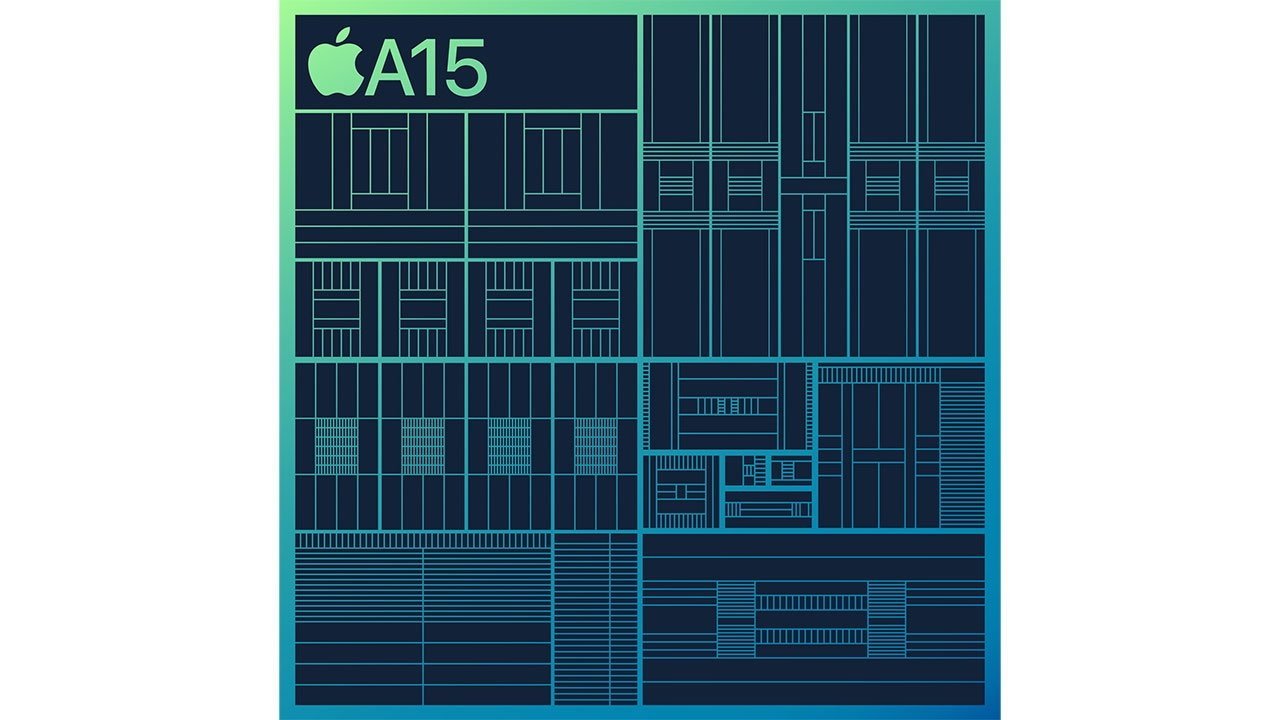
An illustration of the A15 Bionic, as used in the iPhone 13 generation, as well as the iPhone 14 and 14 Plus
The Neural Engine is, again, identical across the two at 16 cores running at 15.8 TOPS. Apple also doubles the GPU core count, with the A15's 5 GPU cores replaced by a 10-core version in the M2.
The comparison does break down slightly for memory, as Apple does limit the bandwidth to 34.1GB/s on the A15, but the M2 offers up to 100GB/s. It is more probable that the A-series is limited by the memory it uses, rather than Apple increasing the bandwidth beyond switching from single-channel to dual-channel memory.M2 vs M3: Extrapolating M3
If Apple is following the same sort of pattern for the M3, we must logically look to the A16 Bionic for its next iteration of Apple Silicon chip.
We know that the A16 Bionic uses six cores for the CPU, consisting of two Everest performance cores clocked at 3.46Hz and four Sawtooth efficiency cores at 2.02GHz. It wouldn't be unexpected for Apple to move to four Everest and four Sawtooth cores for M2, with a modest upgrade in clock speeds to around 3.7GHz and 3GHz respectively.
Since A16 uses a 17 TOPS 16-core Neural Engine, we can expect Applet to stick to what works and to use the same thing in the M3.
On the memory side, Apple still uses single-channel memory in the A16, with over 50GB/s of bandwidth available. Using double-channel in the M3, 100GB/s would be a minimum for Apple to use, though it could again go a bit higher.
Apple's continued use of a 5-core GPU in the A16 may get a doubling yet again in the M3 to 10 cores but at a higher clock speed than the previous generation. That is if Apple doesn't design in more cores anyway.M2 vs. M3: Outlier features
There are some areas that an A-series comparison cannot cover, or that Apple could wildly depart from, if you believe rumors.
For a start, there are its Unified Memory capacities. While M1 uses 8GB and 16GB capacities with M2 extending that range to include 24GB as a third option, Apple may go one step beyond and hit 32GB for the M3.
While the M1 is the only chip in Apple Silicon to not have any form of Media Engine for video encoding and decoding, Apple's inclusion of it in M2 probably means it's a feature that could stick around for M3. Apple could stick to what works in the M2, though it could add more engines to improve the generation's capabilities.
Then there's the manufacturing process, which is another problem for predictions. Apple used a 5-nanometer process to make its A14 and A15 chips, as well as the M1 and M2.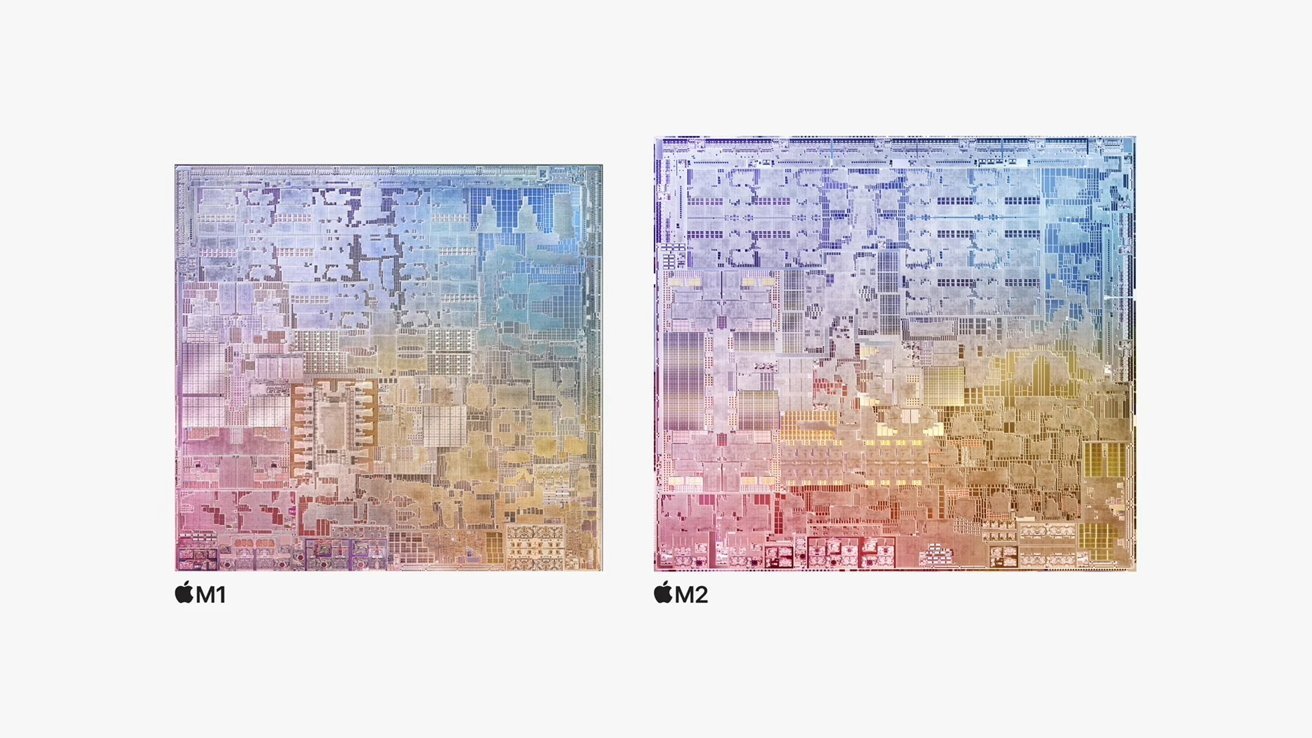
M2's silicon is larger than M1, but with a die shrink, M3 could be smaller.
When it comes to the A16, Apple uses a 4-nanometer process instead. Though Apple could use that for the M3, some early rumors pointed to Apple switching to a 3-nanometer process for both A17 and M3.
Later supply chain rumors in April claimed the shift to 3-nanometer was having teething issues, but that it was still going to be used for M3 after TSMC apparently dedicated the entire production run for Apple in February.
Going to 3nm could give Apple considerable benefits for M3, including performance boosts of around 15% at comparative power levels to 5nm counterpart chips, or a 35% reduction in power consumption for comparable performance.M2 vs. M3: Better performance
With Apple's introduction of a third generation of chip, it's almost certain that there will be some form of performance improvement along the way. We just don't know by how much.
The most obvious way to compare is to look at what Apple itself says about going from M1 to M2. At launch, this included claims of "an 18% faster CPU, a 35% more powerful GPU, and a 40% faster Neural Engine."
Working out where the M3 could take performance could be of a similar level once again. Though, with changes in nanometer and unanswered questions about memory bandwidth, the changes could be considerably larger.
Seeing as we have already raised the A-series chips as a point of comparison, examining the iPhone lineup could give some idea of what to expect.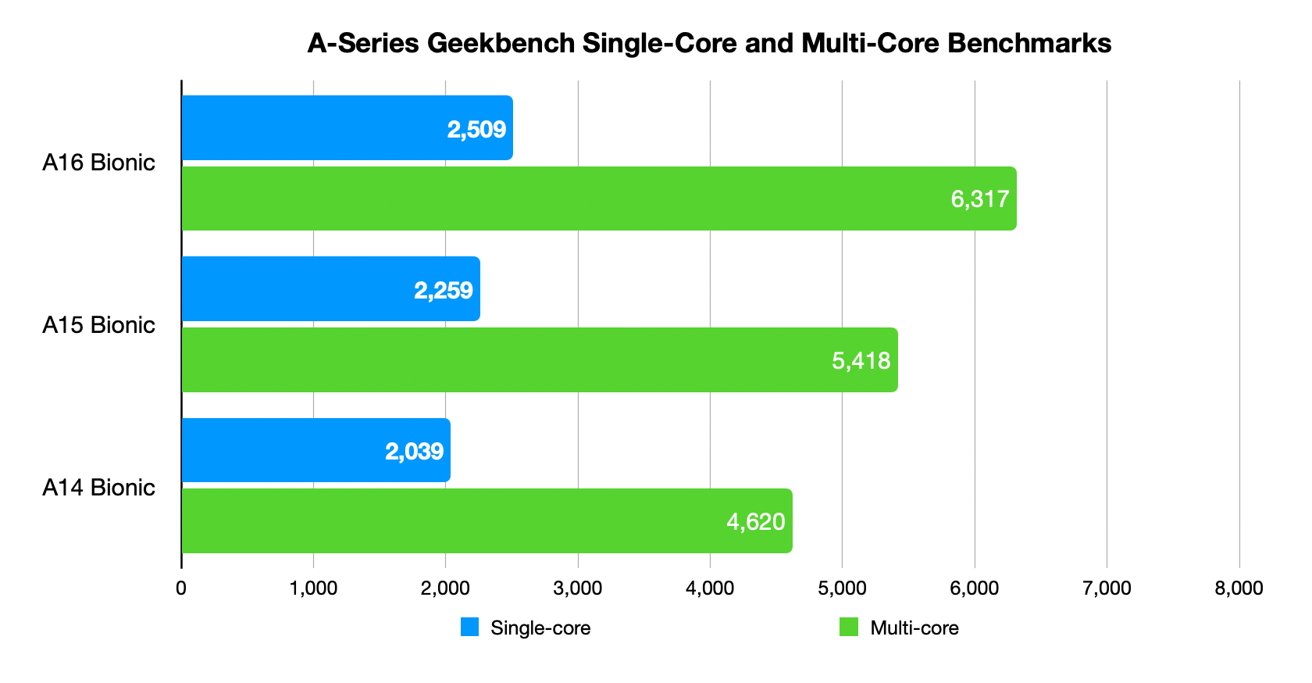
Single-core and Multi-core Geekbench results for Apple's latest A-series chips
Under the Geekbench Browser for iPhone benchmarks, the iPhone 14 Pro Max's A16 has a single-core score of 2,509, a multi-core score of 6,317, and a Metal score of 22,236.
This is an 11% rise in single-core performance from 2,259 for the A15 in the iPhone 13 Pro Max. For multi-core, it's 16% up from the iPhone 13 Pro Max's 5,418 result, and 11% again from the 19,907 Metal score.
That iPhone 13 Pro Max saw gains from the iPhone 12 Pro Max and its A14 Bionic chip. Single-core performance in the A14 rose 10% from the A13's 2,039 score, multi-core saw a 17% rise from 4,620, and a 24% gain from the 15,983 Metal score.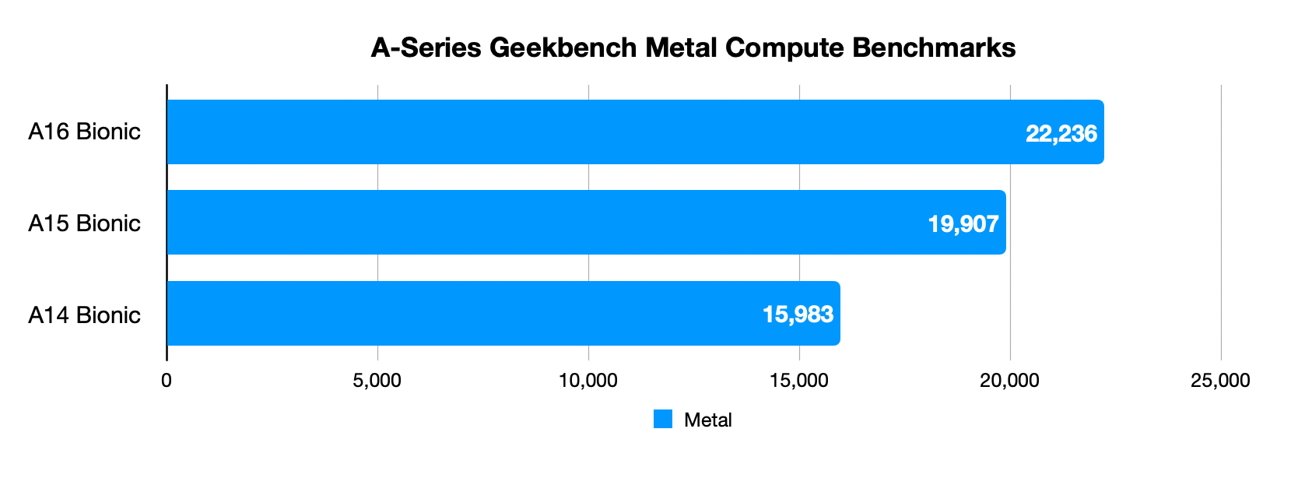
Metal Compute scores for recent A-series releases
While the gains from the A15 to A16 are promising, they aren't directly comparable to the M2-M3 changeover. Differences such as switching from single-channel memory to dual-channel, variances in core counts, and thermal management changes can considerably vary the score progression.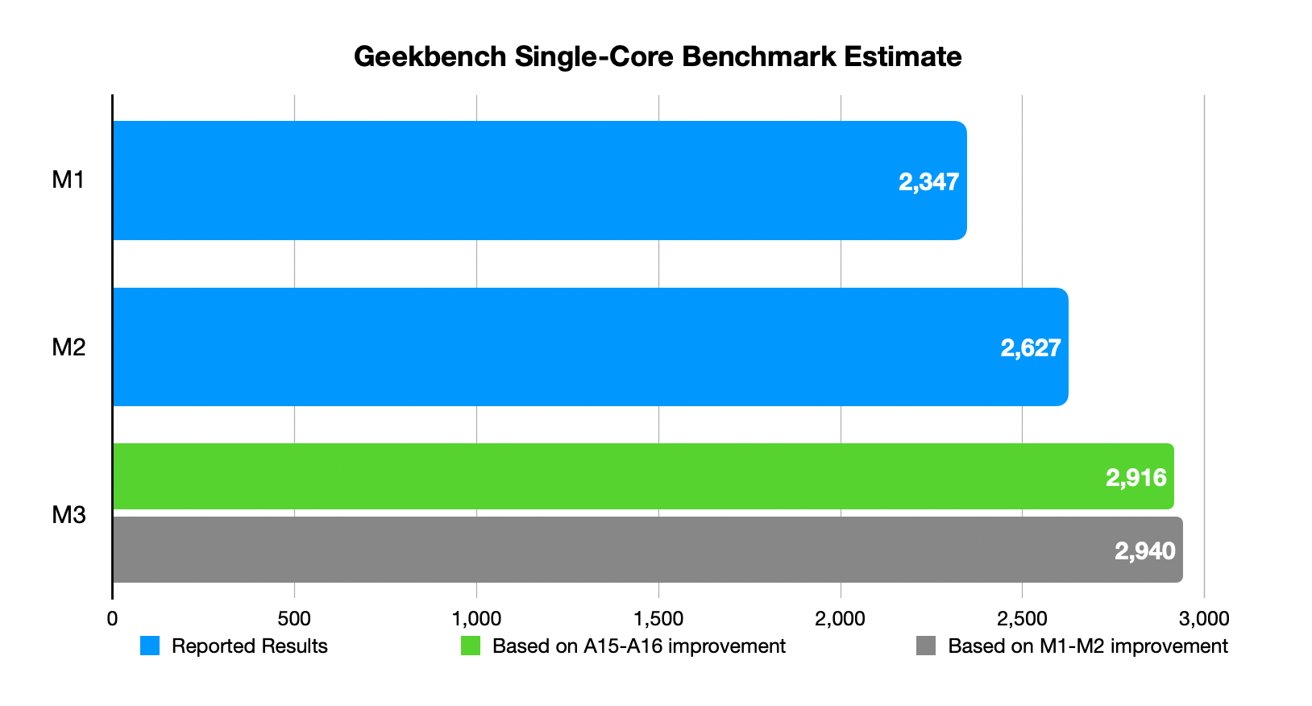
M2 vs M3: Comparing percentage increase estimates for single-core benchmarks
If we looked at the percentage gain in score for single-core performance, there's a fairly similar gain between the M1 and M2, and if you look at the A15 and A16. This is to be expected, given CPU gains aren't typically as massive as GPU or multi-core improvements between generations.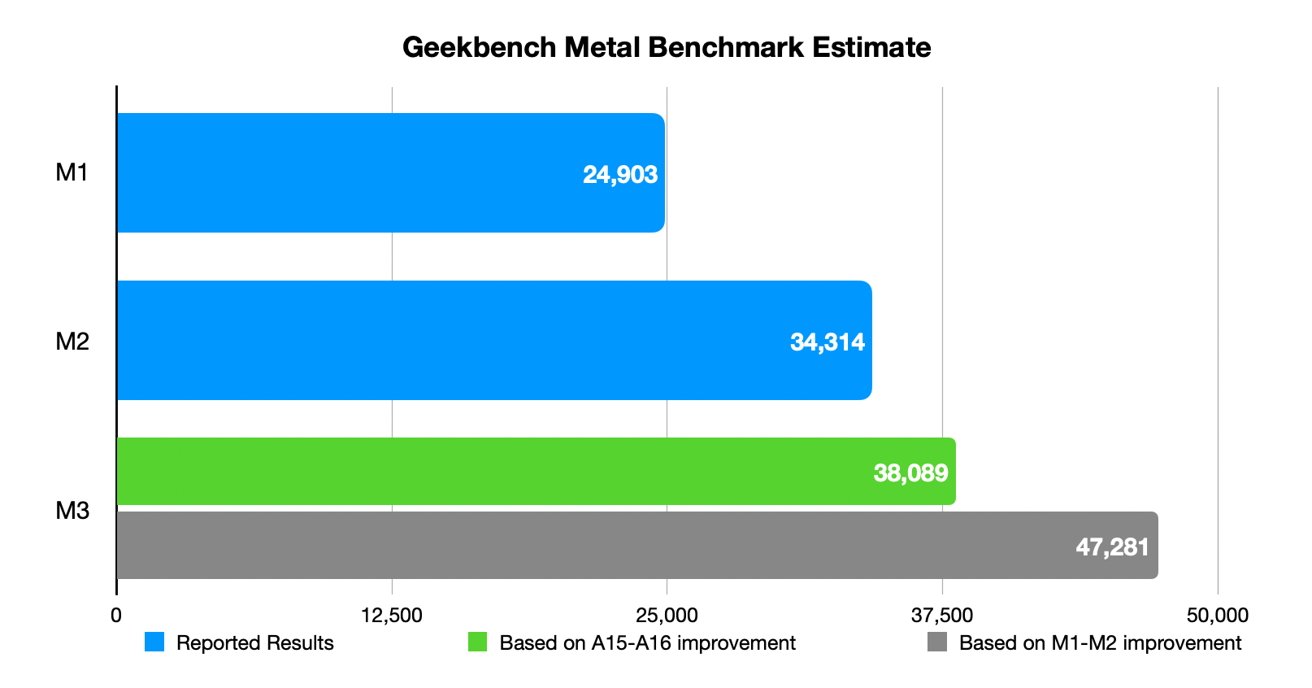
M2 vs M3: On the GPU side, things could improve extremely well, theoretically
Over to the GPU side, and comparing the performance has a lot more variance when it comes to the M3. The equivalent A15 to A16 improvement of 11% for Metal is good, but then there's the 25% boost if you look at A14 to A15.
But if you look at the improvement from M1 to M2, that's a 37% gain. In Metal score terms, that would put the M3's GPU capabilities at around double that of the M1 if the improvement from M2 to M3 mirrored that of the M1 to M2.
Since we don't know enough about the chips, we can't give a more definitive result than this. At least, until Apple brings the chips out.
By using a similar structure to the A16, including the same types of cores, it's certainly plausible that a 10% or greater performance boost over the M2 could be achieved for the CPU, and even more for the GPU. It's not an entirely accurate method, and not exactly guaranteed against what Apple eventually releases to the world, but it's a good starting point for further consideration.
All we can really be sure of is that M3 will be Apple's best Apple Silicon chip generation yet.
Read on AppleInsider

-
Windows won't dominate enterprise in a decade, says outgoing Jamf CEO
Dean Hager of Apple device management firm Jamf predicts Windows will no longer be the dominant enterprise platform, and Apple will take its place.
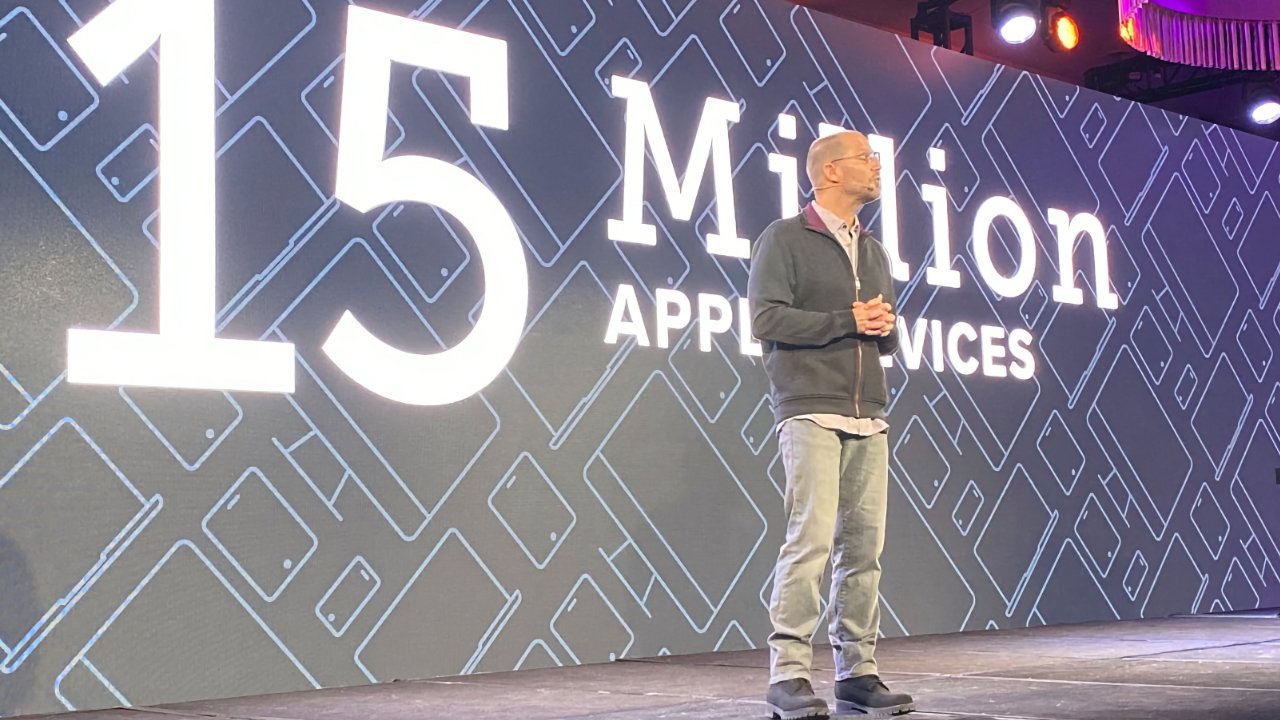
Dean Hager of Jamf
Hager has previously praised Apple's competitor to Jamf, Apple Business Essentials. Now that he is about to stand down, he's predicting Apple will topple Windows in corporations.
"No matter which way you look at it, Windows is a declining ecosystem and has been for 20 years," Hager told ComputerWorld. "That's not a knock at Windows, it's a statement of fact."
"In 10 years' time, Windows will not be the dominant ecosystem," he said. "Apple is coming up because it already dominates the mobile enterprise."
"When I joined Jamf in 2015, I thought some pretty special things were going to happen with Apple in the enterprise," continued Hager. "But I think even my predictions would have fallen far short of what has actually happened in the last eight years."
Hager's point is partly that he says Windows has no mobile device to equal the iPhone, and so can't be what he calls an "endpoint leader." It can't dominate because it isn't competing across the platforms enterprise users want.
But it's also that issue of the customer and their needs.
"We live in an environment where people using the technology have a stronger voice than they've ever had in the history of the corporate world," he said. "And ultimately that voice will prevail."
"[Users] will choose the technology that they want, and this just wasn't true 20 or even 10 years ago," he continued. "But the world has changed, employees have a choice, and those organizations that don't allow that choice are falling behind today."
Following the launch of Apple Business Essentials, aimed at smaller firms, Jamf has added a Jamf Fundamentals plan for the same market.
Read on AppleInsider
-
Judge scolds Apple's lawyers over appeals arguments
A US judge has chided Apple's legal arguments as the company asks for time to appeal an App Store antitrust case, but has granted the delay.

Apple won the lawsuit brought against it by "Fortnite" developer Epic Games, but it didn't win outright. There were some elements of the ruling that required Apple to make changes in its App Store rules, and the company has previously asked for a stay on a number of those.
Specifically, Apple doesn't want to follow the instruction that would see it having to allow apps to link out to alternative payment options. The 9th Circuit upheld the ruling in April, but Apple is now preparing to ask the Supreme Court to strike it down.
According to Reuters, the appeals court has now granted Apple 90 days to file its petition, and in the meantime has paused the ruling. However, Judge Milan Smith wrote in the ruling that the delay is allowed because of "our general practice of granting a motion for a stay if the arguments presented therein are not frivolous."
"I write separately to express my view that, while the arguments in Apple's motion may not be technically frivolous," wrote Judge Smith, "they ignore key aspects of the panel's reasoning and key factual findings by the district court."
"When our reasoning and the district court's findings are considered," continued the ruling, "Apple's arguments cannot withstand even the slightest scrutiny."
"Apple's standing and scope-of-the-injunction arguments simply masquerade its disagreement with the district court's findings and objection to state-law liability as contentions of legal error," said Judge Smith.Sadly, Apple's anti-steering rules - which both the District Court and the 9th Circuit Court found to be illegal - will remain in place, as the 9th Court Court stayed the injunction that puts an end to the practice. Justice delayed, again. https://t.co/I044RIMF9c
-- Tim Sweeney (@TimSweeneyEpic)
Epic Games CEO Tim Sweeney called the decision "Justice delayed, again," on Twitter. As well as starting the lawsuit against Apple, Sweeney has more recently protested that Apple is a "major roadblock in the way of Epic's vision for a metaverse."
Read on AppleInsider
-
Apple Search Ads terms of service update coming on August 8
The Apple Search Ads terms of service is being updated on August 8. Here's what developers need to know about the new terms.
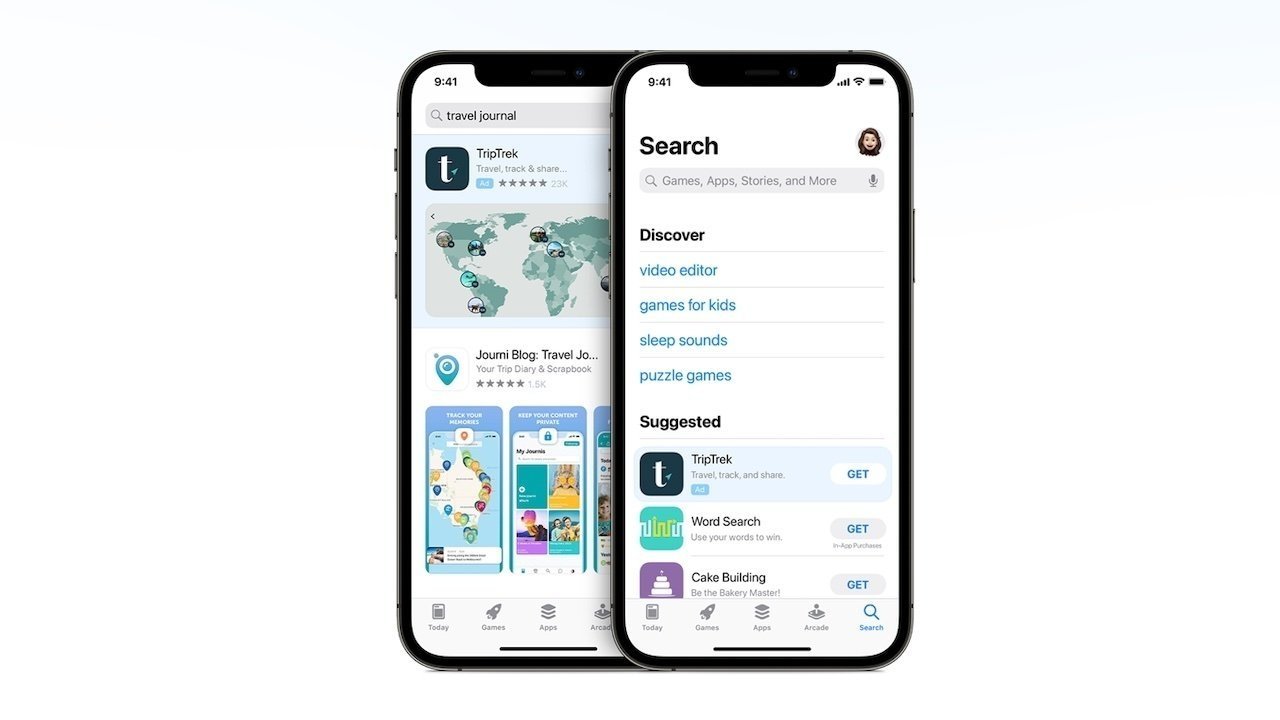
The Apple Advertising Services Terms of Service is a list of rules advertisers must agree to in order to use Apple's advertising platforms. Apple last updated the document on June 22, 2021, but it's about to issue new changes.
The updated terms of service, shared by Apple in advance, will become effective from August 8, 2023.
A comparison of the texts shows there to be a number of changes. The new document is a bit longer, weighing in at 10,448 words to 9,724 in the current version.Advertising Services
The first big change of the document lies in section 6, part d, Advertiser Data. The section deals with enabling Apple to use Advertiser Data, information provided by the advertiser about customers, products, and services, for targeting advertising.
The following new text has been added:You further acknowledge and agree that Apple may use information about Your use of the Services and Your interactions with Apple in connection with the Services, including Advertiser Data and Business User Data, for the purpose of providing, evaluating, modifying, or improving the Services and for communicating about the Services. You further acknowledge and agree that Apple may have a duty to publish or disclose information concerning Your use of the Services, Your Ad Content, or Your Campaigns (including Apple's decision not to display Your Ad Content or Campaigns, or to suspend, terminate or limit display of Your Ad Content or Campaigns), and Apple has no liability to You in connection with any publication or disclosure that Apple considers in good faith to be required pursuant to that duty.
In short, this text allows Apple to use advertiser-derived data in providing the service in the first place, as well as for analyzing what works and what needs alterations. Apple may also have to publish documents based on the data, too.Right to Reject Ad Content
Section 6, part e, Right to Reject Ad Content, has text added in-line, with Apple adding that it reserves the right to "request modifications to Ad Content, including as a condition for approval for dissemination or the continuation of dissemination."
It also reserves the right to "modify Your Ad Content in a non-material manner, including without limitation zooming or cropping, as reasonably necessary to provide the Services. "
"Notwithstanding the foregoing, You are solely responsible for Your Ad Content as provided to Apple," it adds.
The same section also clarifies that "Nothing in this Agreement or Apple's provision of the Services shall be construed as Apple's endorsement of any of Your Ad Content."Content Provider Representations, Warranties, and Covenants
Section 6, part g, Content Provider Representations, Warranties, and Covenants, has new in-line text that "Your access, use, or implementation of the Services shall not exceed the lawful authorization provided by each such third party." The third parties in question cover a number of areas, but generally cover owners of copyright and IP other than the advertiser, and regulatory or law-enforcement bodies.
The text also adds "You authorize Apple to communicate with each such third party as reasonably necessary, including to validate the authorizations specified in Section 6(g)(XI)(i)-(iii) or to provide information or materials required by applicable law or regulations, and You shall assist Apple in such communications upon Apple's request."Incentives
Section 6, part s, is an entirely new section on Incentives. The full text is as follows:Apple may at its discretion offer incentives, including credits, promotions, discounts, or other monetary or non-monetary offerings, to You or other eligible users of the Services in connection with the Service. Your acceptance or use of any such incentives is subject to both these Terms of Service and the Apple Advertising Services Promotional Credits Terms and Conditions (available at https://searchads.apple.com/promo-terms and/or https://ads.apple.com/cn/promo-terms and incorporated into these Terms of Service by reference). You acknowledge and agree that the provision or use of the Services is subject to and may be affected by such incentives, including with respect to cost or price determined through auctions or other pricing mechanisms.
In effect, this text describes how advertisers and users of Apple's ad platform could receive incentives for using it, and that they're bound to the rules in the ToS.Tax Obligations and Requirements
Rather than an addition, Apple does remove large stretches of text relating to regional tax obligations and requirements. In the current form, there are many paragraphs covering the subject, but instead, they have been moved over to separate pages that have yet to be created.
Read on AppleInsider
-
Russia bans officials from using iPhones in U.S. spying row
Russia's Federal Security Service has encouraged thousands of officials in the country to stop using iPhones and Apple products over U.S. surveillance claims, but the officials aren't happy about the order.

Moscow, Russia
Authorities in the country have banned officials and state employees from using Apple hardware, including iPhones and iPads. Ministries and institutions of the government are being prevented from the devices, under continued concern over alleged activities by the U.S. to spy on Russian organizations.
As part of the ban, the trade ministry said it will ban iPhone usage for "work purposes from Monday, reports the Financial Times, while the digital development ministry says it will follow suit.
"Security officials in ministries - these are FSB employees who hold civilian positions such as deputy ministers - announced that iPhones were no longer considered safe and that alternates should be sought, a source close to a government agency told the report.
The FSB and officials "truly believe that Americans can use their equipment for wiretapping," security expert Andrey Soldatov explained. They added that while the FSB has "long been concerned about the use of iPhones for professional contacts," there may be some resistance to the change.
"The presidential administration and other officials opposed [restrictions] simply because they liked iPhones," Soldatov added.
In some cases, ministries apply the restrictions against Apple devices used for official purposes but still permit the use of iPhones and iPads for personal use. A person close to a ministry offered "Everyone complains that it's inconvenient and they have to carry another phone or tablet."
Another cyber security expert, Alexey Lukatsky, added that officials may not necessarily want to actually switch to using devices running the Russian-produced Aurora operating system. "There were restrictions on the use of work email on devices not certified by [security services] before. But most officials did not comply," Lutatsky explains, before wondering how many "will comply now."
The latest round of restrictions follow after a June 1 announcement by the FSB claiming the U.S. National Security Agency had used backdoor vulnerabilities in the iPhone, with Apple supposedly involved in the creation of the backdoors.
Apple was quick to flat-out deny the FSB's claims, insisting on June 2 that the company has "never worked with any government to insert a backdoor into any Apple product."
Read on AppleInsider
